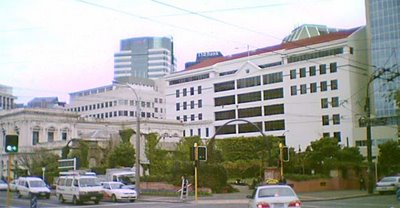Suprema a situ
Update: the chosen design (by Warren & Mahoney) has just been announced.
Yesterday the government announced that the new Supreme Court will be built on what is currently Justice Park, at the north end of Lambton Quay adjacent to the historic former High Court building.

Previous plans involved housing the Supreme Court in the refurbished High Court building, but it proved impossible to come up with a plan that suited both the judges and the Historic Places Trust. There were also suggestions that a new building might be constructed further into the Government Precinct, specifically on the corner of Molesworth and Pipitea streets where the derelict modernist Thorndon Tavern is now. But this plan involves both the refurbishment of the historic courts and the creation of a new building, which has yet to be designed but is apparently to be "a symbol of national identity" and "a structure which people will look to in future with pride". In other words, the complete opposite of the current High Court building, which has to be one of the most forgettable structures in Wellington.
 I hope that the architects (whoever they may be) aren't required to be too deferential to the old High Court building. It is aesthetically appealing, and highly significant since it's our first major non-timber public building, but to build an addition or companion building in a contemporary attempt at neo-Classicism would be a disaster. There are successful precedents for creating uncompromisingly modern additions to historic neo-Classical public buildings (Norman Foster's Reichstag conversion is a prime example), so the brief should be: "respond to the context, engage with the site, but let your imagination run free".
I hope that the architects (whoever they may be) aren't required to be too deferential to the old High Court building. It is aesthetically appealing, and highly significant since it's our first major non-timber public building, but to build an addition or companion building in a contemporary attempt at neo-Classicism would be a disaster. There are successful precedents for creating uncompromisingly modern additions to historic neo-Classical public buildings (Norman Foster's Reichstag conversion is a prime example), so the brief should be: "respond to the context, engage with the site, but let your imagination run free".Some people will no doubt miss the current park, but the new building isn't expected to take up all the space, so there will still be public landscaped grounds around it. Also, if the building heeds good urban design principles it should provide the remaining space with more shelter and active edges than the current park. Jan Gehl (58kB PDF) described its current state as:
"an under-utilized city park ... an introverted space with a poor relationship to the street. The possible reuse of this site for the new Supreme Court Building can only improve the space and bring more people to the area."And if the government has the courage to give free rein to our best architects, then this could be a truly exciting space to watch.



2 Comments:
How do you know whether it is expected to take up all the park or not? Is there a brief announced yet? Surely the judges will want humungous amounts of lush new suites, sweeping halls, seaside vistas, secluded rooftop gardens, separate entrances, etc...?
and with the cost just tripling then won't there be a need for 3 times as much accomodation?
No brief yet, but the DomPost article I linked to mentioned that "The new building will be surrounded by landscaped grounds for the public to use."
They were having trouble squeezing all those humungous suites into the old building, but with both old & new buildings there should be enough for even the fussiest judge. Probably.
Post a Comment
<< Home